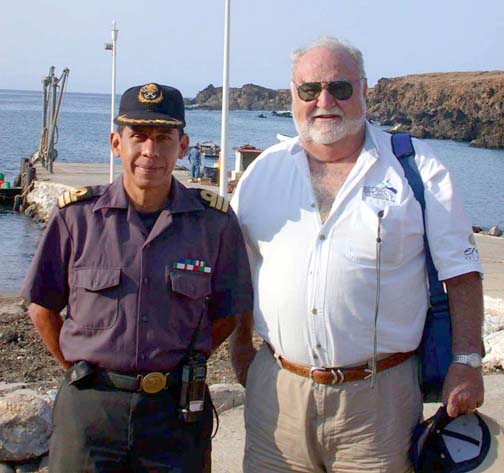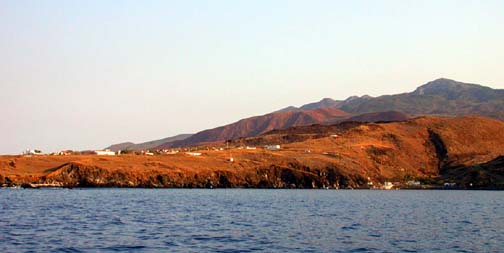
Visit to Mexico's Isla Socorro
![]()
|
Capt. Frag. C. G. Miguel Lopez Ortiz (left), acting commander of the Mexican Navy detachment on Isla Socorro, Mexico, with Julio Berdegué Aznar, representing Mexico's Consejo Nacional de Pesca y Aguacultura. |
A REMOTE NAVY DETACHMENT OVERSEE'S MEXICO'S
PROTECTED REVILLAGIGEDO ISLAND BIOSPHERE
By Gene Kira, May 13, 2002, as published in Western Outdoor News:
It had been a long but pleasant, 221-mile crossing from the Mexican mainland at Mazatlan to Cabo San Lucas at the tip of Baja California for fuel, and then an additional 294 miles down-swell, to Mexico's remote Pacific island, Isla Socorro.
As Julio Berdegué's 70-foot Hatteras, Regal Lady, crossed into the outer edge of the Revillagigedos Island Biosphere Reserve, I celebrated with an ice cream bar and stood at the bow rail, noting the sudden increase in sea life all around us. After an uneventful voyage across the profound abyss, we were suddenly treated to the sight of jumping tuna and porpoise, and a great density of sea birds; you could feel the power of the island's upwellings, creating this tiny dot of life in the expanse of the Pacific Ocean.
|
|
The Regal Lady slid to its sunset anchorage at the south end of the island, and I kept one eye glued on the color video fathometer. Sure enough, as we passed over a huge rock in about 30 fathoms of water, I noted perhaps the clearest and strongest fish echoes I'd ever seen. The bottom was simply plugged with big fish, and I had the sacrilegious thought: What would happen if you dropped a chrome Salas 6X into that gigantic, bright red echo?
But we had not crossed 500 miles of water in order to go fishing. I had caught this ride with Don Julio Berdegué--all the way from his El Cid Mega Resort in Mazatlan--in order to document his findings as a representative of Mexico's Consejo Nacional de Pesca y Aguacultura.
The next morning, we met with the Mexican Navy detachment's acting commanding officer, Capt. Frag. C. G. Miguel Lopez Ortiz, and after the customary formalities, I asked the Big Question: "Are the islands really closed to all sport and commercial fishing?"
As his reply, Capt. Lopez showed us a message from Mexico City dated May 3, 2002. It could not have been more clear. Effective immediately, all fishing of any type was prohibited in both the Nucleus Zones and Buffer Zones; no fishing is allowed within 12 miles of the islands. (The only exception to this rule is that the Navy itself, which has been stationed at the island since January 19, 1957, may fish for food.)
Nevertheless, Capt. Lopez explained that although he has a frigate with a helicopter, a twin-engine aircraft, and several smaller boats at this disposal, it is obviously difficult to patrol the entire archipelago, which occupies a triangular area of ocean roughly 280 statute miles wide and 40 miles north-and-south.
|
The Mexican Navy's lonely outpost perched above the life-filled waters of Isla Socorro. |
|
Isla Socorro's anchorage on the south side of the island. |
We sat in Capt. Lopez' offices and studied all the "fishing" permits issued to sport boats this season. None of these actually allowed fishing. If you paid for a Biosphere permit this year, you got an entry permit only, not a fishing permit, despite what you may have been told by your agent. Your other, SAGARPA boat fishing permit only allows you to fish in general Mexican waters, not restricted waters, such as inside a Biosphere Reserve. That much is quite clear.
But, as he gave us a personal tour of the island--including the 4,000-foot paved runway and the substantial, sharply-maintained, hurricane-proof buildings--Capt. Lopez explained that several legal questions remain:
Should total-catch-and-release fishing be permitted? What types of fishing equipment may be carried by visiting boats? What types and quantities of fish caught elsewhere may be in possession inside the Biosphere Reserve? "We need clear regulations on these matters," he said.
Meanwhile, he said, the Mexican Navy will board boats caught fishing inside the Biosphere Reserve, and they will be impounded, pending legal proceedings. This is the current fate of three commercial boats caught recently, the Blufin, the Jesus Nevares, and the Luz Meras. Under present conditions, it is the possibility of this type of impoundment--not minute-by-minute patrolling--that is the main deterrent to fishing inside the Biosphere Reserve.
At our bathtub warm anchorage that evening, we were treated to a spectacle of whales, manta rays, jacks, needlefish, a thick plankton soup attracted to our lights, and the very strange sight of two porpoises gently swallowing foot-long flying fish only a few feet from our swim step. These fish came flying in, and then stopped dead on the surface, waiting for the porpoises to slowly inhale them. Why should they allow themselves to be eaten in this way?
It was a wondrous mystery of the life-filled Revillagigedos Biosphere Reserve, and I felt privileged to witness it.
|
Small boat landing on the south side of remote Isla Socorro off the Pacific coast of Mexico. |
(Related Mexico articles and reports may be found at Mexfish.com's main Mexico information page. See weekly fishing news, photos, and reports from the major sportfishing vacation areas of Mexico including the Mexico area in "Mexico Fishing News.")
MEXICO FISHING INFO MEXICO FISHING INFO "WEEKLY MEXICO FISHING NEWS" FISH PHOTO GALLERY



